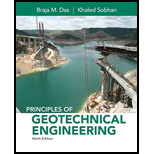
Find the magnitude and location of the passive force
Answer to Problem 14.11P
The magnitude of the passive force
The location of the resultant measured from the bottom of the wall is
Explanation of Solution
Given information:
The magnitude of surcharge loading (q) is
The unit weight
The height (H) of the retaining wall is 7.0 m.
The soil friction angle
The angle of wall friction
The cohesion
The soil-wall interfall adhesion
The horizontal inertial
The vertical inertial
Calculation:
Determine the ratio of angle of wall friction to the soil friction angle.
Determine the ratio of soil-wall interfall adhesion to the cohesion.
Determine the magnitude of the passive force due to earthquake conditions using the formula.
Here,
Refer Figure (14.9b) “Variation of
For
Take the value of
Refer Figure (14.10b) “Variation of
For
Take the value of
Refer Table (14.7) “Variation of
For the ratio of angle of wall friction to the soil friction angle is 0.5.
The value of
Substitute
Thus, the magnitude of the passive force
Determine the unit weight of the passive force
Substitute
Determine the distance of passive earth force acting above the bottom of the wall using the relation.
Substitute 7.0 m for H.
Determine the weight of surcharge component using the formula.
Substitute
Determine the distance of surcharge component acting above the bottom of the wall using the relation.
Substitute 7.0 m for H.
Determine the unit weight of the cohesion component using the formula.
Substitute
Determine the distance of cohesion component acting above the bottom of the wall using the relation.
Substitute 7.0 m for H.
Determine the location of the resultant measured from the bottom of the wall using the formula.
Substitute
Thus, the location of the resultant measured from the bottom of the wall is
Want to see more full solutions like this?
Chapter 14 Solutions
Principles of Geotechnical Engineering (MindTap Course List)
- Determine the magnitude and the location of the active thrust on the smooth vertical wall shown assuming that the entire backfill is in the active state.arrow_forwardA frictionless vertical retaining wall has a height of 4 meters and retains a horizontal surcharge of 11 kPa. The unit weight of the backfill is 15 kN/m3 with cohesion of 8 kN/m2 and an angle of friction of 260. Compute the active force (in kN) after the tensile crack.Answer: 26.82arrow_forward3) A 5-m-high retaining wall is shown in Figure-2. Determine A) Rankine active force per unit length of the wall and the location of the resultant B) Rankine passive force per unit length of the wall and the location of the resultantarrow_forward
- Use Eq. (12.3), Figure P12.2, and the following values to determine the at-rest lateral earth force per unit length of the wall. Also find the location of the resultant. H = 5 m, H1 = 2 m, H2 = 3 m, γ = 15.5 kN/m3, γsat = 18.5 kN/m3, Φ' = 34º, c' = 0, q = 20 kN/m2, and OCR = 1.arrow_forwardPLEASE ANSWER ASAP A 6-m vertical unyielding retaining wall is supporting a cohesionless loose coarse-grained backfill having a unit weight of 16 kN/m3 and an angle of friction of 250. It carries a uniform surcharge of 15 kN/m3. Determine the total lateral force (in kN) per unit length of the wall.arrow_forward45.) A retaining wall supports a horizontal backfill that is composed of two types of soil. First layer: 5.91 meters high, Unit weight of 17.26 kN/m3, coefficient of active pressure of 0.291 Second layer: 5.36 meters high, Unit weight of 18.85 kN/m3, coefficient of active pressure of 0.301 Determine the distance of the total active force measured from the bottom of the wall. Round off to three decimal places.arrow_forward
 Principles of Geotechnical Engineering (MindTap C...Civil EngineeringISBN:9781305970939Author:Braja M. Das, Khaled SobhanPublisher:Cengage Learning
Principles of Geotechnical Engineering (MindTap C...Civil EngineeringISBN:9781305970939Author:Braja M. Das, Khaled SobhanPublisher:Cengage Learning Principles of Foundation Engineering (MindTap Cou...Civil EngineeringISBN:9781337705028Author:Braja M. Das, Nagaratnam SivakuganPublisher:Cengage Learning
Principles of Foundation Engineering (MindTap Cou...Civil EngineeringISBN:9781337705028Author:Braja M. Das, Nagaratnam SivakuganPublisher:Cengage Learning Fundamentals of Geotechnical Engineering (MindTap...Civil EngineeringISBN:9781305635180Author:Braja M. Das, Nagaratnam SivakuganPublisher:Cengage Learning
Fundamentals of Geotechnical Engineering (MindTap...Civil EngineeringISBN:9781305635180Author:Braja M. Das, Nagaratnam SivakuganPublisher:Cengage Learning


